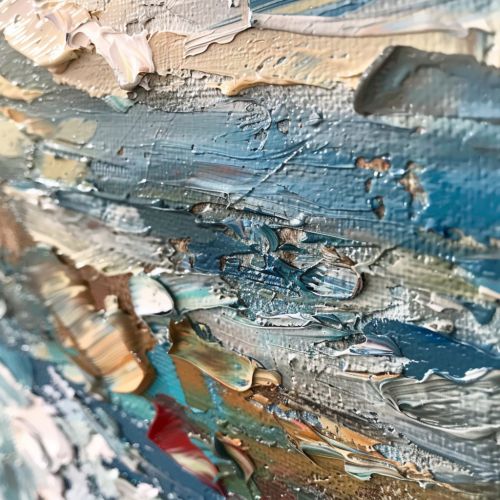Impasto
Origins and History
Impasto is a technique used in painting, where paint is laid on an area of the surface in very thick layers, usually thick enough that the brush or painting-knife strokes are visible. Paint can also be mixed right on the canvas. When dry, impasto provides texture, the paint appears to be coming out of the canvas. Oil paints and acrylic paints are most commonly used for impasto painting, due to their thick consistency and slow drying time.
Impasto is an Italian term, which translates to 'dough' or 'mixture'. The technique has been used since the times of Rembrandt and Titian, and it can add an expressive quality to a painting. The technique was also used by artists like Vincent van Gogh to convey mood and emotion.


Technique
The impasto technique involves applying paint in large amounts, often with a palette knife, to achieve a textured surface that captures and reflects light in a unique way. The thickness of the paint application varies from slight to extreme, with some artists using layers of paint that are several inches thick.
Impasto can be used to create a variety of effects, from the subtle texture of slightly thickened paint to dramatic, sculptural peaks and valleys of color. The technique can add a three-dimensional quality to a painting, giving the illusion of depth and structure.
Materials and Tools
Impasto painting can be achieved using various types of paint, the most common being oil and acrylic. Both these types of paint are thick and slow-drying, which makes them ideal for this technique.
The tools used for impasto painting are typically palette knives or painting knives. These tools allow the artist to apply thick layers of paint and to create texture. Brushes can also be used, but they tend to produce a different effect.
Impasto in Art History
Impasto has been used by many artists throughout history. In the Renaissance, Titian used the technique to create a sense of depth and volume in his paintings. Rembrandt, a Dutch painter from the 17th century, is known for his extensive use of impasto, especially in his portraits.
In the 19th century, the Impressionists, including artists like Claude Monet and Pierre-Auguste Renoir, used impasto to capture the play of light on their subjects. Vincent van Gogh, a Post-Impressionist, is perhaps one of the most famous users of the impasto technique. His paintings are known for their thick, swirling brushstrokes.
Modern Usage
Today, impasto continues to be a popular technique among artists. It is often used in abstract expressionism, a movement that emerged in the mid-20th century. Artists like Jackson Pollock and Willem de Kooning have used impasto in their work.
In contemporary art, impasto is used to create a variety of effects. Some artists use the technique to add a sculptural quality to their work, while others use it to enhance the expressive quality of their paintings.
